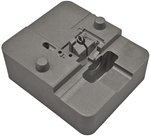Business Slowing? There's Still Plenty of Stuff to Do
There are things you may have put off when you were occupied with shipping parts to customers. Maybe it’s time to put some of them on the front burner.
Business conditions for most plastics processors have slowed down. This is evident in the research we conduct and publish every issue in this magazine. The industry was firing on all cylinders through the Covid-19 pandemic and beyond. Sure, there are processing segments still going strong — packaging and medical, in particular — but for the most part, processors are not quite as busy as they were a year or so ago.
What do you do when business slows, apart from taking a breath. I have some ideas I’d like to share:
• Re-engage with the outside world: Attendance at trade shows and technical conferences for the past few years has not been as robust as in prior years. Of course, the global pandemic and the shutdowns that ensued played a huge role in that. But even when things started to settle, processing firms were either too busy or perhaps a bit too cautious to send their technical people out and about to mingle with others.
We know there is still a thirst for information. Registration for our webinars has climbed since the pandemic, but isn’t it time for you to venture out for more face-to-face engagement? We saw positive signs this was starting to happen in March during our PTXPO trade show, which experienced a healthy climb in attendance. And we are hoping for the same for our upcoming Molding 2023 and Extrusion 2023 conferences. And the NPE2024 trade show is less than a year away. Are you planning to attend any of these?
• Revisit your strategic plan: Or if you don’t have one, get on it. Long-term planning can generally fall by the wayside when the machines are humming and you’re busy filling customer orders — especially in the case of the small- to medium-size companies that are the bread and butter of the plastics processing market. But when you have time to take a breath, revisit your plan and adjust it if necessary. What are your strengths? Weaknesses? What opportunities beckon for you to expand? What threats loom that might prevent growth.
Have you ever heard of a SWOT analysis? (That’s Strengths-Weaknesses-Opportunities-Threats.) It’s a healthy exercise and one that you might want to consider conducting for your business.
• Do a deep-dive investigation of new technologies: Can you add more automation to your process to help mitigate labor shortages? Are you looking at 3D printing technologies (aka additive manufacturing) as a means to add to the range of services you can provide your customers (or perhaps gain new ones)? Will you be ready when your customers demand that you include more scrap/recycled material into your process? Or if your customer asks about your usage of renewably sourced or biopolymers? And what about AI? Yes, I know AI can be scary, but some processors are already using artificial intelligence to help solve production problems.

Wisconsin Molder Nicolet Plastics recently used Mantle's 3D printer and materials to build metal production tooling. By printing three inserts, Nicolet reduced toolmaking time from 180 hr to 12.5 hr and reduced the time to produce the first molded part samples (above; for customer Gamber-Johnson) from six weeks to two weeks. Printed inserts were 95% complete and required only minor finishing before molding began. (Photo: Mantle)
• Look into training: Training is one of those things that most people would say is critical to their business. It also one of those things that processors put off when things get hectic. Business will pick up again, and when it does, I imagine you’ll want to run your production lines as efficiently as possible. Training your operator personnel has been shown to help.
• Do some housekeeping: I’ve been to my share of processing plants in my 35+ year career in plastics journalism. I know full well that plastics — like all other manufacturing operations — can be messy. I also know that processors at the top of their game generally operate out of extremely clean facilities. What do you want yours to look like when you have a customer drop by?
Related Content
Welcome to our NPE2024 Show Issue
Megatrends such as sustainability are the driving force behind a slew of new product introductions at the May show. Catch up on what’s in store on the show floor right here.
Read MoreNot Your Grandpa’s Plastics Processing Operation
New materials and machinery offer processors the means to run their businesses more efficiently and more inline with the circular economy. But you have to say yes.
Read MoreClosing Arguments: The Future of Plastics Processing
As I depart the “big chair” in charge of content, rather than reflect on the past, I project on the future.
Read MoreRegister Now for PTXPO 2023
New trade show for plastics processors to evaluate new technology will be held for the second time in March in Rosemont, Ill., with some new wrinkles.
Read MoreRead Next
Production Tool, Prototype Time
Mantle's metal 3D printing technology targeted toolmaking and injection molders and moldmakers are taking notice.
Read MoreWestminster Tool and Mantle Partner on 3D-Printed Mold Technology
The Connecticut mold maker will be one of two beta-testing sites for Mantle’s TrueShape metal 3D printer, with a medical device already borne out of an ongoing collaboration.
Read MoreNovel Metal 3D-Printing Technology Optimized for Plastic Tooling
A new company called Mantle offers 3D printing equipment and materials that boast unique suitability for producing injection mold components, overcoming limitations of other printing methods.
Read More






















